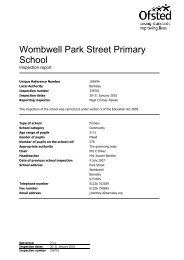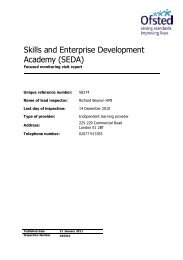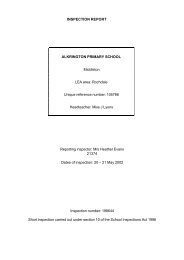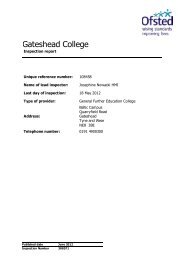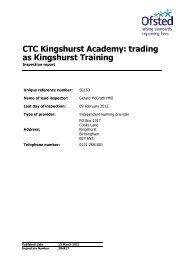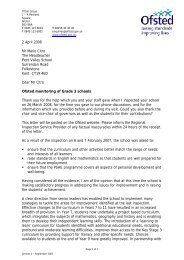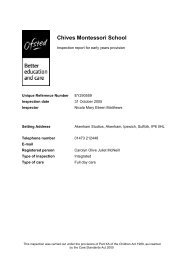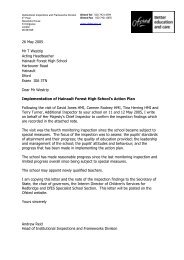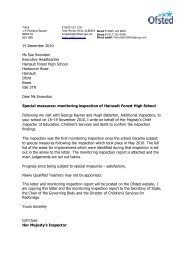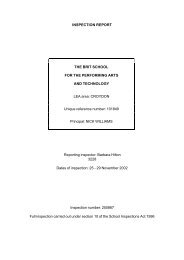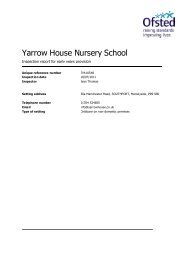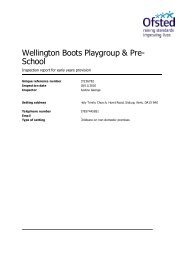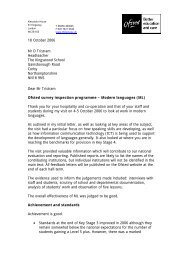pdf School inspection report - Ofsted
pdf School inspection report - Ofsted
pdf School inspection report - Ofsted
You also want an ePaper? Increase the reach of your titles
YUMPU automatically turns print PDFs into web optimized ePapers that Google loves.
What could be improved<br />
• Raise standards, especially in English and mathematics, across the school.<br />
• Attendance and punctuality are unsatisfactory with only 88 per cent attendance recorded in<br />
recent months and pupils are regularly late.<br />
• The governing body it is not sufficiently active and does not act as a critical friend, reacting to<br />
situations created within the school rather than having its own vision for the school’s future and<br />
holding it to account.<br />
• The school administration has good manual accounts but has not yet introduced computerised<br />
systems which would give access to more detailed information about finances and aid the<br />
management of the school.<br />
• Comprehensive monitoring of teaching and the curriculum takes place and whilst this is used to<br />
develop the curriculum effectively, the development of teaching skills is incidental rather than<br />
planned.<br />
The areas for improvement will form the basis of the governors’ action plan.<br />
HOW THE SCHOOL HAS IMPROVED SINCE ITS LAST INSPECTION<br />
The school was last inspected on 11 November 1996. Progress since then has been good. The<br />
introduction of the National Literacy Strategy is beginning to impact on standards and has had a<br />
beneficial effect on writing, which was identified as a particular weakness in the last <strong>inspection</strong>.<br />
Standards remain very low because of pupils’ significantly disadvantaged backgrounds and because<br />
all pupils speak English as an additional language with few opportunities to practise speaking English<br />
out of school hours. At both Key Stages 1 and 2 there is evidence that improvement is occurring in<br />
standards compared with similar schools. Pupils are well above average at Key Stage 1 in reading<br />
and writing and very high in mathematics. At Key Stage 2 pupils are in line in English and<br />
mathematics and above in science. The introduction of the National Numeracy and Literacy<br />
Strategies have strengthened pupils’ language development and number skills, but at this relatively<br />
early stage of implementation have had greater impact at Key Stage 1 than Key Stage 2. The use of<br />
setting of pupils in literacy and numeracy has been particularly effective. In mathematics pupils’<br />
understanding of space, shape, and problem solving, remains an area for development, as it was in<br />
the last <strong>inspection</strong>. There has been significant improvement in science since the last <strong>inspection</strong>,<br />
especially in experimental and investigative science. Information and communication technology has<br />
improved significantly especially at Key Stage 2. The increased provision of computers in the new<br />
suite and additions to the software used have had a marked effect on standards, which are better<br />
than the last <strong>inspection</strong>. Standards in art are good at both key stages and have improved since the<br />
last <strong>inspection</strong>. In religious education pupils now gain deeper knowledge and standards have<br />
improved and teaching is better. Teaching is very good, overall, and there was no unsatisfactory<br />
teaching during the <strong>inspection</strong>. This is a significant improvement from the last <strong>inspection</strong>. It is the<br />
cumulative effect of these improvements which has raised standards.<br />
Greenhill Community <strong>School</strong> - 8



